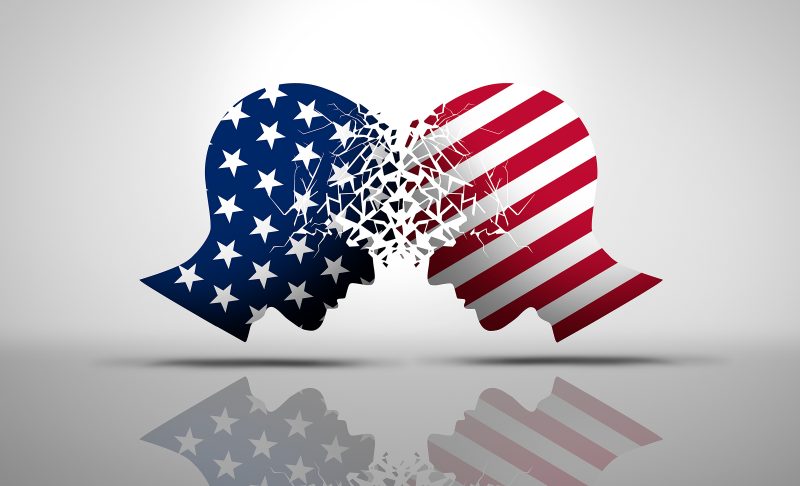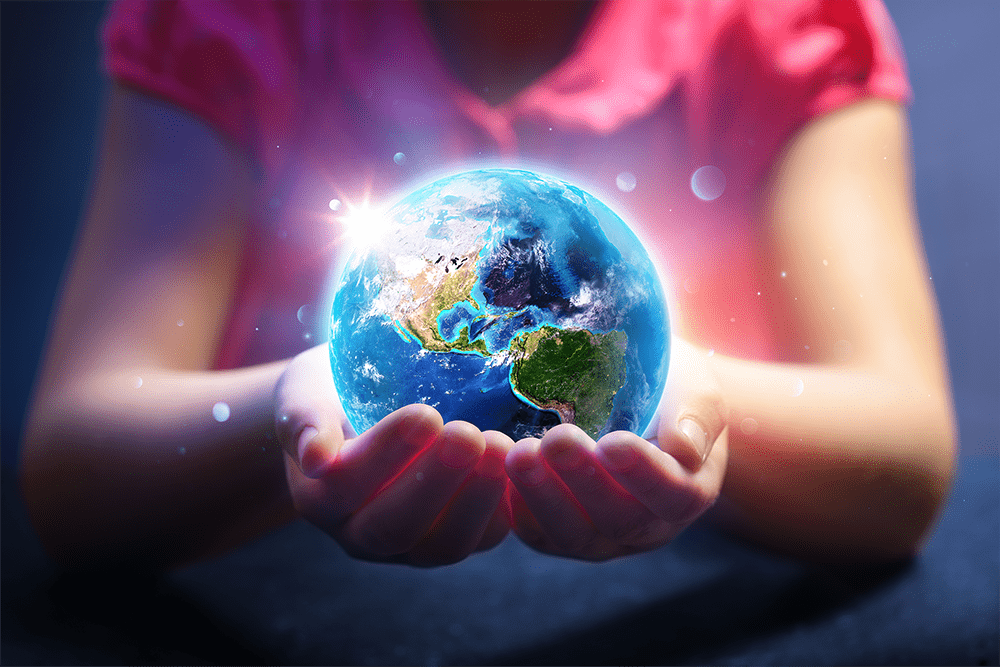POLARIZATION ISN’T JUST AFFECTING OUR GOVERNMENT—it’s trying to push us all into opposing camps on many issues. The middle is emptying out.
While political polarization is ramping up in both the US and Europe, in this article we’re focused on the American political scene. According to the introduction to a 2017 Pew Research Center’s report,
“A new study by Pew Research Center, based on surveys of more than 5,000 adults conducted over the summer, finds widening differences between Republicans and Democrats on a range of measures the Center has been asking about since 1994, as well as those with more recent trends. But in recent years, the gaps on several sets of political values in particular—including measures of attitudes about the social safety net, race, and immigration—have increased dramatically.” (“The Partisan Divide on Political Values Grows Even Wider,” October 5, 2017). That was in 2017. By 2022, the gap has grown even wider.
Why is this happening? We need to figure out why we’re becoming more polarized so we can reverse the trend and join with people who have different perspectives to solve the urgent problems threatening our world. Polarization is complex: its causes are many—some obvious, others hidden. And they interact together as a dynamical force.
Human nature
Does human nature play a role? We think so, and yet this isn’t mentioned often. These aspects of our nature encourage polarization: we’re tribal, we fear people different from ourselves, and we’ve been taught to see the world around us through the lenses of an outdated set of assumptions. These traits interact together to create conflict, which is endemic to polarization.
Tribalism. We humans need to belong to a tribe, a group of similar people. Our tribes include our families, our religious or spiritual groups, our work colleagues, fellow sports fans, our school mates, etc. We also have these tribes called political parties, because based on family background, education and life experiences, people will naturally skew in different political directions. As E. O. Wilson said,
“In ancient history and prehistory, tribes gave visceral comfort and pride from familiar fellowship, and a way to defend the group enthusiastically against rival groups. It gave people a name in addition to their own and social meaning in a chaotic world. It made the environment less disorienting and dangerous. Human nature has not changed. Modern groups are psychologically equivalent to the tribes of ancient history. As such, these groups are directly descended from the bands of primitive humans and prehumans.” (Newsweek, 4/2/12: “Biologist E. O. Wilson on Why Humans, Like Ants, Need A Tribe”)
Our racial identities also play into this divisiveness. Amy Chua, professor at Yale Law School and author of Political Tribes: Group Instinct and the Fate of Nations, points out that the white majority in the US, definitely a tribe, is threatened with demotion into minority status in the future. Fear of this change is undoubtedly a factor in the current polarization trend. (https://www.theatlantic.com/video/index/570043/amy-chua/).
In the political arena this tendency toward tribal group cohesion works against inter-party collaboration, especially at times when the stakes for winning are high.
Fear of the Other. One reason we are tribal is that we humans are naturally most at ease with others like us. Racial, class and religious differences, for example, can cause us to feel at odds with others—especially in stressful times. Try attending the worship service of an unfamiliar religion or joining an organization whose members are not of your race. We guarantee you’ll feel uncomfortable at first. You won’t know the people or the behavioral cues, and above all, you won’t know what assumptions are shared by the group.
When we live in communities and when we work, worship, and go to school with people who share our identities, we lack opportunities to get to know those unlike us. Not knowing what they’re like or how they think, we make up assumptions about them, often negative because of our fear of what’s different. That happens in the political arena also.
Today, in our highly polarized culture, Republicans and Democrats no longer understand where the other party is coming from. Each party’s views of the other are increasingly hostile. The parties interpret everything differently, initially because of their values, but increasingly because the antagonism between the two parties reinforces their different viewpoints. As icing on this toxic cake, some politicians see a value in creating chaos and polarization. Stirring up fear and anxiety, even hatred and violence, is an excellent tool for those who want to capture a controlling share of political power or disrupt democracy. Some media corporations have taken sides and now spout disinformation and misinformation as if it were the norm, courting the favor of their tribe.
These two aspects of “being human,” tribalism and fear of the other, lead us naturally toward polarization. But there’s more.
The way we’re taught to see the world
Polarization is also borne out of the way most of us apprehend the world around us and interpret all we experience. As this Chaos Institute website describes, our society operates within the constructs of an old but still dominant paradigm, which was inspired by the scientific revolution said to have begun in the year 1543. We call it the “fragmentation paradigm.” That’s over 400 years of influence! The assumptions generated by that revolution shape almost everything we encounter in the present. (In contrast, recent scientific discoveries are suggesting a different way of understanding reality: we call the set of assumptions growing out of chaos and complexity theories the emerging “relationship paradigm.”)
How does the current fragmentation paradigm contribute to polarization? First, it’s a recipe for conflict. It suggests that the world is a clock (per Sir Isaac Newton), and if you take the clock apart down to its smallest parts and understand each one, when you reassemble it, you’ll understand the whole structure. Newton was saying that what’s important is the nature of each of the parts of a whole system, but this focus on the nature of the parts neglects the way they interact. It basically ignores process and relationships of all kinds. It also suggests that hierarchy is the most important organizing structure in nature and that truth is absolute. When all aspects of this paradigm coalesce, they lead to competition, either/or thinking and conflict.
In a society structured by the hierarchical fragmentation paradigm, conflict and competition are endemic. Money, power, and domination are ubiquitous goals. Unless laws and regulations curb their all-out drive toward maximum profit, corporations often become cut-throat. As companies compete to ascend to the top of their relevant hierarchies, greed can overpower their consideration of long-term consequences and their humanitarian impulses, leaving consumers, employees, and Mother Earth to absorb the cost. As corporations gain more wealth and power, our culture pushes them to use it to expand their business, often to the detriment of the public. What follows is the bifurcation of society into two groups: the haves and the have nots. Meeting basic human needs across the planet is not a consideration for the corporate world unless there’s potential profit in sight, because the dynamic of this paradigm requires that all efforts be directed toward growing the business.
The environmentalist, Paul Hawken, provides an example of the lengths to which corporations and trade organizations will go to achieve their ends when profit eclipses other goals.
“In June 1992, the Supreme Court unanimously upheld a decision by the lower courts authorizing local towns and cities to enact and enforce their own laws concerning pesticides. The town of Casey, Wisconsin, had passed ordinances that were stricter than federal standards and that had been immediately challenged in court by the chemical companies. When Casey finally prevailed in the Supreme Court, trade associations (including the National Pest Control Association and the Professional Lawn Care Association of America) joined to create a new organization called the Coalition for Sensible Pesticide Policy (CSPP). A trade journal, arguing passionately for this cause, listed measures for companies to take if ‘legislation is rearing its ugly head in your community.’ Industry groups have had bills sponsored in the Senate and House that would preempt the Supreme Court ruling, disallowing local legislation of toxic pesticides. When Missoula, Montana, tried to pass a referendum calling for tighter controls on local spraying of chemicals, trade associations, along with Ciba-Geigy and DuPont, spent over $50,000 to defeat it.” (The Ecology of Commerce: A Declaration of Sustainability, by Paul Hawken, Harper Business, 1993, p. 114)
Another consequence of this paradigm is the tendency to see things as simple opposites instead of as points on a spectrum. We call this either/or thinking. It’s natural for us to see the world this way. When we’re using this mental framework, there is no spectrum, no middle ground—just the two opposing items, which we see in contrast to one another. These for example: night/day, happy/sad, Republican/Democrat. This familiar structure, which is dictated by the fragmentation paradigm, gives polarization its mental foundation.
In summary, the fragmentation paradigm, with its emphasis on hierarchy, either/or thinking and absolute truth is like a petri dish with all the right nutrients to grow polarization. What doesn’t grow well in it are the understanding of relationships, caring about long-term consequences of our actions, and considering context. Obligations to community and the planet and care for all living beings also find limited support in this environment.
A word about relationships, whose importance is minimized in the fragmentation paradigm. We’re talking about relationships of all kinds: those among humans, and those among items and events. Understanding which relationships are important in any situation allows you to foresee hidden ramifications of actions you’re planning and to be able to increase your chances for success.
Here’s a simple example. Imagine you’re starting a new organization in your community. You’re eager to get it up and running. The group begins by writing a mission statement and planning events. Without first exploring which other community groups and individuals share your interests, you may be treading on another group’s turf. You’re also not taking advantage of any help they may be able to give to you. In contrast, you also need to know who in the community might be opposed to the work you’re planning so you can mitigate conflicts.
Relationships are particularly important when you’re trying to solve complex problems. Since all the large challenges threatening the planet and our civilization are complex, ignoring relationships will impede any attempts to solve them.
In the context of the fragmentation paradigm, the presidential, two-party political system we have in the US makes good sense. This structure lends itself well to both either/or thinking and polarization, both of which function using the same dynamic. Unfortunately, political polarization can lead to legislative gridlock. These days, watching the US legislature try to pass bills that would benefit the whole nation is like watching grass grow. No one paying any attention to what’s going on in Washington, DC will need to be convinced of that.
Who feeds the monster?
Here’s our situation. The fragmentation paradigm has been creating social structures for over 400 years; the United States has had a two-party political system since the 1790s; and tribalism and fear of others who are different are dictated by human nature. Polarization has been part of America since its inception. And yet now it’s increasing. What’s fueling that?
Confusion, for one thing. First, we live in an increasingly complex world, but we don’t understand complexity, so we’re confused about how to solve complex problems. Second, technology brings so much detailed information into our lives—much more than earlier generations had to deal with, and that information-overload distracts and confuses us. Third, some American individuals along with, apparently, the Russian government (with its interference in the 2016 election) have intentionally tried to confuse the American public. One purpose is to cause people to distrust traditional sources of information—journalism and the media outlets that broadcast the news (a strategy used by fascists). Another is to weaken our democracy.
Confusion makes people want the comfort and dependability of the familiar, so they stick to their basic beliefs and their identification with one of the two political parties—their tribe, often the party of their parents. They don’t want to think deeply about their political identity because what’s happening in politics here and around the world is too complicated. “I’ll just stick with my party.” And then they block out any information that threatens that loyalty.
Disillusionment is also a contributor. Tom Jacobs writes in the Pacific Standard (“The Emotional Roots of Political Polarization,” Feb. 14, 2018) of three studies by University of Limerick psychologists Paul Maher and Eric Igou that show how disillusionment causes people to search for meaning and understanding. “This quest often prompts people to double down on their pre-existing belief systems, leading them to endorse more extreme views.” One study involved people in Britain whose levels of disillusion were measured both before and after the Brexit vote, and another measured levels of disillusion before and after the 2016 presidential election in the US. In both cases, individuals who were on the losing side indicated more disillusion and extreme beliefs than they felt before the votes and more than those on the winning side afterward. These events increased polarization in Britain and the U.S.
Social media separates groups of people as well. People choose who can be a “friend” on their sites and whom to follow in their social media accounts. The more they listen only to people who share their views, the more they begin to believe they’re in the majority and that they’re on the side of the truth. News accounts shared among friends tend to become more exaggerated as they are shared, deepening the gulf between groups with opposite viewpoints. Then when events happen that people are vehemently opposed to, they’re set up for even more intense disillusionment. In addition, social media companies track the tenor of users’ postings and place ads on their pages that reflect their interests, thus amplifying their beliefs.
Paradigm Evolution is happening as we speak, and it, too, intensifies polarization. While it’s a difficult process, in and of itself this evolution into the relationship paradigm is a good thing. It represents an enormous change in the way people apprehend and make sense of the world around them. The new paradigm builds on the old one. We still care about the individual parts and their content or identity, but we now understand that we can’t stop at that. What’s most important is knowing how everything behaves, how “this” affects “that,” and which dynamic forces are operating in the system. These forces partially control the systems they’re in. That’s why this new focus adds more accurate meaning to what we could know by using the old approach alone.
However, the process of shifting paradigms itself causes problems. Because we’re in the middle of this shift, some people are mired in the old worldview, while others have transitioned into this new focus. Each group has different assumptions about the world and different values. People who are more fearful of change and usually more conservative cling to the old views, while those who can accept that these views no longer work well in our complex, rapidly changing world (and who are usually more liberal) welcome the new mental framework of the relationship paradigm. To make matters more complicated, identification with a paradigm is typically subconscious. Therefore, conservatives and liberals can begin to think the opposition group is simply crazy. Communication between them breaks apart on the shoals of different subconscious values and assumptions.
These four forces—confusion, disillusionment, social media, and the paradigm shift—are intensifying the polarization that was already in place. It may take some cataclysmic event whose importance and urgency are greater than political differences to override it. But why wait for disaster? It’s also possible that helping more and more people understand why and how we are polarized and helping them find some common ground that might build a bridge between opposing parties can weaken the grip of polarization we’re experiencing today. This Chaos Institute website is a step in that direction. We hope our readers will help spread this understanding.
3/4/22





